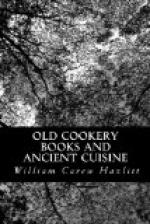He proceeds to say that he noticed no regular inns, with signs hanging out, but that private householders would entertain passengers on entreaty, or where acquaintance was claimed. The last statement is interestingly corroborated by the account which Taylor the Water-Poet printed in 1618 of his journey to Scotland, and which he termed his “Penniless Pilgrimage or Moneyless Perambulation,” in the course of which he purports to have depended entirely on private hospitality.
A friend says: “The Scotch were long very poor. Only their fish, oatmeal, and whiskey kept them alive. Fish was very cheap.” This remark sounds the key-note of a great English want—cheaper fish. Of meat we already eat enough, or too much; but of fish we might eat more, if it could be brought at a low price to our doors. It is a noteworthy collateral fact that in the Lord Mayor of London’s Pageant of 1590 there is a representation of the double advantage which would accrue if the unemployed poor were engaged to facilitate and cheapen the supply of fish to the City; and here we are, three centuries forward, with the want still very imperfectly answered.
Besides the bread and oatmeal above named, the bannock played its part. “The Land o’ Cakes” was more than a trim and pretty phrase: there was in it a deep eloquence; it marked a wide national demand and supply.
The “Penny Magazine” for 1842 has a good and suggestive paper on “Feasts and Entertainments,” with extracts from some of the early dramatists and a woodcut of “a new French cook, to devise fine kickshaws and toys.” One curious point is brought out here in the phrase “boiled jiggets of mutton,” which shews that the French gigot for a leg of mutton was formerly in use here. Like many other Gallicisms, it lingered in Scotland down to our own time.
The cut of the French cook above mentioned is a modern composition; and indeed some of the excerpts from Ben Jonson and other writers are of an extravagant and hyperbolical cast,—better calculated to amuse an audience than to instruct the student.
Mr. Lucas remarks: “It is probable that we are more dependent upon animal food than we used to be. In their early days, the present generation of dalesmen fed almost exclusively upon oatmeal; either as ’hasty-pudding,’—that is, Scotch oatmeal which had been ground over again, so as to be nearly as fine as flour;... or ’lumpy,’—that is, boiled quickly and not thoroughly stirred; or else in one of the three kinds of cake which they call ‘fermented,’ viz., ‘riddle cake,’ ‘held-on cake,’ or ‘turn-down cake,’ which is made from oatcake batter poured on the ‘bak’ ston’’ from the ladle, and then spread with the back of the ladle. It does not rise like an oatcake. Or of a fourth kind called ‘clap cake.’ They also made ‘tiffany cakes’ of wheaten flour, which was separated from the bran by being worked through a hair-sieve tiffany, or temse:—south of England Tammy,—with a brush called the Brush shank.”




